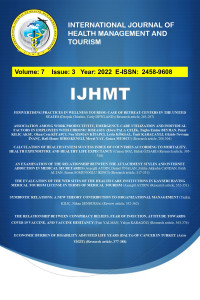Abstract
Aim: Collaborations established by living things belonging to different species in nature are considered as "Symbiotic Relations" in Biology. The purpose of this research is to determine whether similar relationships exist at the healthcare, maritime and other industries and organizational level.
Methods: The research was handled in a descriptive type. In this context, the conceptual framework of the subject was created by examining the Management and Biology literature.
Results: In addition, whether the defined symbiotic relationships exist in existing industries has been exemplified by making inferences from observations and reports.
Conclusion: As a result of the research, it was determined that healthcare, maritime, tourism, textile, food, universities and technology industries mainly developed mutualism, partially commensalism and parasitism in a limited number of their relationships.
Keywords
Symbiotic relationships in organizations health tourism maritime tourism maritime piracy win-win relationship
References
- Ashton, W. S. (2011).Managing performance expectationsofindustrial symbiosis.Business Strategy and the Environment, 20, 297-309. https://doi.org/10.1002/bse.696
- Banwo, A. O., Jianguo, D., & Onokala, U. (2015). Symbiotic Innovative Relationships of Small and Medium Enterprises. Journal of Advanced Management Science, 3 (2), 128-131. https//doi.org/10.12720/joams.3.2
- Çetin, O. (2009). Denizcilik Sektöründe Mukayeseli Bir Model. Güvenlik Stratejileri Dergisi, 5(10), 35-58.
- Chertow MR, 2000. INDUSTRIAL SYMBIOSIS: Literature and Taxonomy. Annual Review of Energy and the Environment, Vol. 25(1), 13–337.
- EKOIQ. (2014, Dec 20). Bir Kaynak Verimliliği Aracı Olarak Endüstriyel Simbiyoz. https://ekoiq.com/2014/12/20/bir-kaynak-verimliligi-araci-olarak-endustriyel-simbiyoz/
- Kılıç, T. (2019). Güncel Yönetim Paradigmaları. İstanbul: AZ Yayınları.
- Köksal, O. (2011). Organizasyonel Etkinliği Sağlamanın Yeni Yolu: Simbiyotik Liderlik. C.Ü. İktisadi ve İdari Bilimler Dergisi, 12(1), 55-72.
- Lee, S. M., & Lee, D. (2020). Healthcare wearable devices: an analysis of key factors for continuous use intention. Serv Bus, 14, 503–531. https://doi.org/10.1007/s11628-020- 00428-3
- Önal, E. (2021, Sept 12). “Köminütelerde Simbiyotik İlişkiler”. Biyoloji Portali. http://www.biyolojiportali.com/konu-anlatimi/21/8/Komunite-Ekolojisi
- Papathanassis, A. (2020). The growth and development of the cruise sector: a perspective article. Tourism Review, 75(1), 130-135. https://doi.org/10.1108/TR-02-2019-0037
- Phaneuf, A. (2021, Nov 10). Latest trends in medical monitoring devices and wearable health technology. Business Insider. www.businessinsider.com/wearable-technology- healthcare-medical devices#:~:text=What%20is%20wearable%20healthcare%20technology,users'%20perso nal%20health%20and%20exercise
- Rauch, A., Rosenbusch, N., Unger, J., & Frese, M. (2016). The effectiveness of cohesive and diversified networks: A meta-analysis. Journal of Business Research, 69, 554-568. https://doi.org/10.1016/j.jbusres.2015.05.011
- Tontuş, Ö. (2019). Sağlık Turizmi Nedir? Tüm Yönleriyle Sağlık Turizmi Kitabı. Ankara: Saturk Y ayınları. United Nations Conference on Trade and Development (2018). Review of Maritime Transport 2018. United Nations Conference on Trade and Development Publication, Geneva. https://unctad.org/system/files/official-document/rmt2018_en.pdf
- Ushaş. (2021). Sağlık Turizmi Verileri. https://www.ushas.com.tr/saglik-turizmi-verileri/ Oxford University Press. (n.d.). Symbiotic. In Oxford Advanced Learner's Dictionary. Oxford University Press. Retrieved November 4, 2021, from www.oxfordlearnersdictionaries.com/definition/english/symbiotic?q=symbiotic
- Technology Development Foundation of Turkey. (2021). Eko-Verimlilik Ve Endüstriyel Simbiyoz Faaliyetleri. Retrieved October 22, 2021, from https://www.ttgv.org.tr/tr/ekosistem- gelistirme/devam-eden-projeler
- Van Berkel R, 2009. Comparability of Industrial Symbioses. Journal of Industrial Ecology, Vol. 13 (4), 483–486.
- Zaccaro, S. J., & Horn, N. J. Z. (2003). Leadership Theory and Practice: Fostering an Effective Symbiosis. The Leadership Quarterly, 14, 769-806. https://doi.org/10.1016/j.leaqua.2003.09.009
Abstract
References
- Ashton, W. S. (2011).Managing performance expectationsofindustrial symbiosis.Business Strategy and the Environment, 20, 297-309. https://doi.org/10.1002/bse.696
- Banwo, A. O., Jianguo, D., & Onokala, U. (2015). Symbiotic Innovative Relationships of Small and Medium Enterprises. Journal of Advanced Management Science, 3 (2), 128-131. https//doi.org/10.12720/joams.3.2
- Çetin, O. (2009). Denizcilik Sektöründe Mukayeseli Bir Model. Güvenlik Stratejileri Dergisi, 5(10), 35-58.
- Chertow MR, 2000. INDUSTRIAL SYMBIOSIS: Literature and Taxonomy. Annual Review of Energy and the Environment, Vol. 25(1), 13–337.
- EKOIQ. (2014, Dec 20). Bir Kaynak Verimliliği Aracı Olarak Endüstriyel Simbiyoz. https://ekoiq.com/2014/12/20/bir-kaynak-verimliligi-araci-olarak-endustriyel-simbiyoz/
- Kılıç, T. (2019). Güncel Yönetim Paradigmaları. İstanbul: AZ Yayınları.
- Köksal, O. (2011). Organizasyonel Etkinliği Sağlamanın Yeni Yolu: Simbiyotik Liderlik. C.Ü. İktisadi ve İdari Bilimler Dergisi, 12(1), 55-72.
- Lee, S. M., & Lee, D. (2020). Healthcare wearable devices: an analysis of key factors for continuous use intention. Serv Bus, 14, 503–531. https://doi.org/10.1007/s11628-020- 00428-3
- Önal, E. (2021, Sept 12). “Köminütelerde Simbiyotik İlişkiler”. Biyoloji Portali. http://www.biyolojiportali.com/konu-anlatimi/21/8/Komunite-Ekolojisi
- Papathanassis, A. (2020). The growth and development of the cruise sector: a perspective article. Tourism Review, 75(1), 130-135. https://doi.org/10.1108/TR-02-2019-0037
- Phaneuf, A. (2021, Nov 10). Latest trends in medical monitoring devices and wearable health technology. Business Insider. www.businessinsider.com/wearable-technology- healthcare-medical devices#:~:text=What%20is%20wearable%20healthcare%20technology,users'%20perso nal%20health%20and%20exercise
- Rauch, A., Rosenbusch, N., Unger, J., & Frese, M. (2016). The effectiveness of cohesive and diversified networks: A meta-analysis. Journal of Business Research, 69, 554-568. https://doi.org/10.1016/j.jbusres.2015.05.011
- Tontuş, Ö. (2019). Sağlık Turizmi Nedir? Tüm Yönleriyle Sağlık Turizmi Kitabı. Ankara: Saturk Y ayınları. United Nations Conference on Trade and Development (2018). Review of Maritime Transport 2018. United Nations Conference on Trade and Development Publication, Geneva. https://unctad.org/system/files/official-document/rmt2018_en.pdf
- Ushaş. (2021). Sağlık Turizmi Verileri. https://www.ushas.com.tr/saglik-turizmi-verileri/ Oxford University Press. (n.d.). Symbiotic. In Oxford Advanced Learner's Dictionary. Oxford University Press. Retrieved November 4, 2021, from www.oxfordlearnersdictionaries.com/definition/english/symbiotic?q=symbiotic
- Technology Development Foundation of Turkey. (2021). Eko-Verimlilik Ve Endüstriyel Simbiyoz Faaliyetleri. Retrieved October 22, 2021, from https://www.ttgv.org.tr/tr/ekosistem- gelistirme/devam-eden-projeler
- Van Berkel R, 2009. Comparability of Industrial Symbioses. Journal of Industrial Ecology, Vol. 13 (4), 483–486.
- Zaccaro, S. J., & Horn, N. J. Z. (2003). Leadership Theory and Practice: Fostering an Effective Symbiosis. The Leadership Quarterly, 14, 769-806. https://doi.org/10.1016/j.leaqua.2003.09.009
Details
| Primary Language | English |
|---|---|
| Journal Section | Makaleler |
| Authors | |
| Publication Date | November 20, 2022 |
| Submission Date | September 7, 2022 |
| Acceptance Date | October 21, 2022 |
| Published in Issue | Year 2022 Volume: 7 Issue: 3 |

